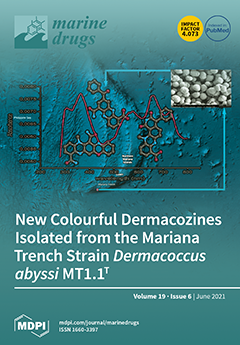For utilizing the largest source of marine proteins, Antarctic krill (
Euphausia superba) proteins were defatted and hydrolyzed separately using pepsin, alcalase, papain, trypsin, and netrase, and alcalase hydrolysate (EPAH) showed the highest DPPH radical (DPPH·) and hydroxyl radical (HO·) scavenging activity
[...] Read more.
For utilizing the largest source of marine proteins, Antarctic krill (
Euphausia superba) proteins were defatted and hydrolyzed separately using pepsin, alcalase, papain, trypsin, and netrase, and alcalase hydrolysate (EPAH) showed the highest DPPH radical (DPPH·) and hydroxyl radical (HO·) scavenging activity among five hydrolysates. Using ultrafiltration and chromatography methods, fifteen antioxidant peptides were purified from EPAH and identified as Asn-Gln-Met (NQM), Trp-Phe-Pro-Met (WFPM), Gln-Asn-Pro-Thr (QNPT), Tyr-Met-Asn-Phe (YMNF), Ser-Gly-Pro-Ala (SGPA), Ser-Leu-Pro-Tyr (SLPY), Gln-Tyr-Pro-Pro-Met-Gln-Tyr (QYPPMQY), Glu-Tyr-Glu-Ala (EYEA), Asn-Trp-Asp-Asp-Met-Arg-Ile-Val-Ala-Val (NWDDMRIVAV), Trp-Asp-Asp-Met-Glu-Arg-Leu-Val-Met-Ile (WDDMERLVMI), Asn-Trp-Asp-Asp-Met-Glu-Pro-Ser-Phe (NWD-DMEPSF), Asn-Gly-Pro-Asp-Pro-Arg-Pro-Ser-Gln-Gln (NGPDPRPSQQ), Ala-Phe-Leu-Trp-Asn (AFLWA), Asn-Val-Pro-Asp-Met (NVPDM), and Thr-Phe-Pro-Ile-Tyr-Asp-Tyr-Pro-Gln (TFPIYDPQ), respectively, using a protein sequencer and ESI/MS. Among fifteen antioxidant peptides, SLPY, QYPPMQY and EYEA showed the highest scavenging activities on DPPH· (EC
50 values of 1.18 ± 0.036, 1.547 ± 0.150, and 1.372 ± 0.274 mg/mL, respectively), HO· (EC
50 values of 0.826 ± 0.027, 1.022 ± 0.058, and 0.946 ± 0.011 mg/mL, respectively), and superoxide anion radical (EC
50 values of 0.789 ± 0.079, 0.913 ± 0.007, and 0.793 ± 0.056 mg/mL, respectively). Moreover, SLPY, QYPPMQY and EYEA showed strong reducing power, protective capability against H
2O
2-damaged plasmid DNA, and lipid peroxidation inhibition ability. Furthermore, SLPY, QYPPMQY, and EYEA had high stability under temperatures lower than 80 °C, pH values ranged from 6–8, and simulated GI digestion for 180 min. The results showed that fifteen antioxidant peptides from alcalase hydrolysate of Antarctic krill proteins, especially SLPY, QYPPMQY and EYEA, might serve as effective antioxidant agents applied in food and health products.
Full article






